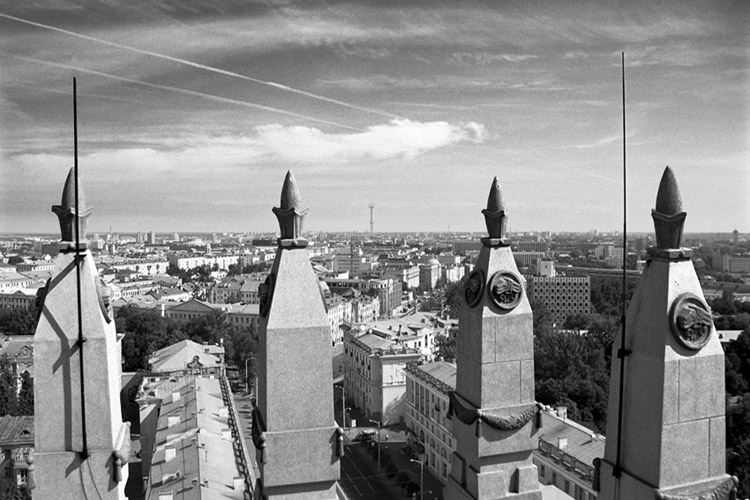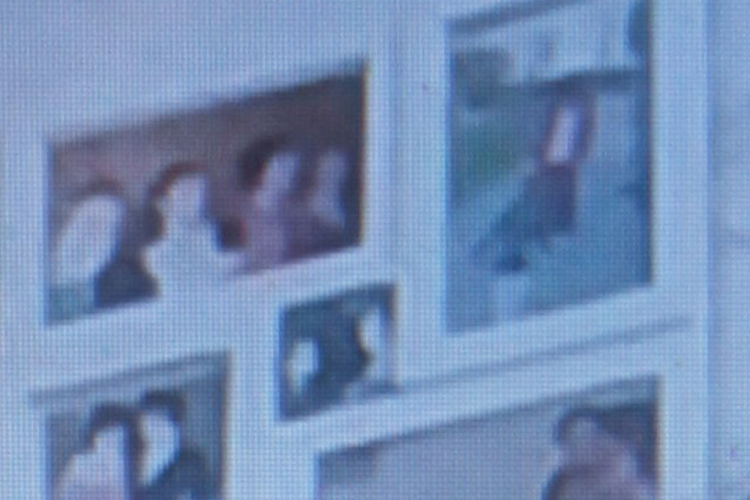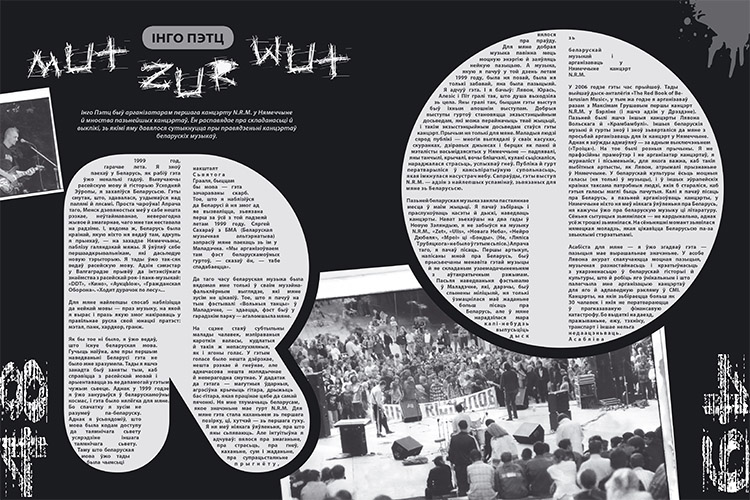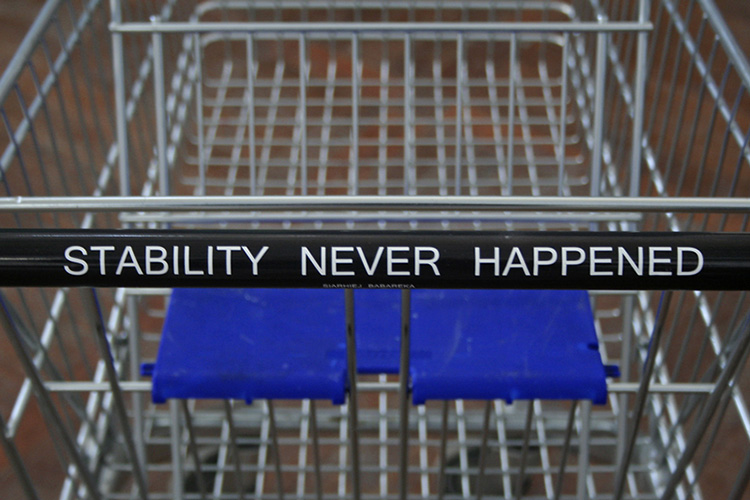
Аўтар: pARTisan, 03/11/2012 | SPECIAL
Artur Klinau: A Project to Build an Ideal City
Archive! © Published in pARTisan #9’2009
Interview with Artur Klinau, an author of A Visual Poem The Sun City of Dreams and A Little Guidebook of the Sun City about his project The City of the Sun’2, which could make Minsk one of the most attractive touristic city.
Minsk city authorities have recently presented a plan to construct a number of buildings on the territory of such a unique architectural gem as the Sun City. The proposed projects, like the high-rise Kempinski hotel in Kastrycnićkaja Square, a similar skyscraper near the State Art Museum, a 25-storey block of flats opposite the Opera House and others will change the invaluable architectural ensemble beyond recognition. There is already some monstrosity sticking out opposite the HQ, which has immediately spoilt one of the most beautiful places of the city. In a few years we may lose the Sun City altogether. Do you think there is still a chance to save it?
Artur Klinau: I’m afraid in some five or ten years such a phallic construction will be erected in every courtyard along the main thoroughfare. But we still have a chance. The economic crisis has given us a brief reprieve. Yet, the land in the Sun City is very expensive, which makes it attractive for developers. Lovebirds of a bureaucrat plus a developer can breach any law. We will not save the city by fighting for each building separately. The problem must be solved systemically on the highest level.
The only chance to rescue the unique architectural ensemble is to adopt a large-scale investment program for the Sun City.
So what is your program for the Sun City?
A. K.: The idea is to turn Minsk into a major European tourist and cultural centre. If the Sun City program begins working to its full capacity, we will be able to sell half a billion dollars’ worth of tourist services annually. In addition, billions of dollars will be invested in infrastructure, such as hotels, museums, restaurants, entertainment facilities, etc.
Recently the authorities have made public a plan to construct a dozen high-rise hotels, which means that investors are prepared to put their money in the city even without your project.
A. K.: Most of these plans will never be fulfilled, as they a but fragment of a chaotic, non-systemic investment scheme, which lacks the backbone of a concept, so it is doomed. Just think, who will need the hotels, if there are only 6,500 tourists visiting Minsk every month? Once the first two hotels have been constructed, it will become evident that there is no point in building the rest, as there will be no guests. Or do you think millions of tourists will swarm the city just to admire the Kempinski hotel? No, if there is anything to attract them it is the unique architectural ensemble of the Sun City. Once the Kempinski is erected in the heart of the architectural monument, we will forever have missed our chance. Our programme aims to make hotels financially viable. For this purpose, construction projects must not ruin Minsk’s uniqueness.
OK, but how are you going to attract millions of foreign tourists?
A. K.: If there is, say, a pyramid in your city, you are lucky. You can make good money from tourists, who are willing to came and see it. We do have such a pyramid. It is an unparalleled architectural ensemble of the Sun City, a monument neither the French nor the Germans nor the Swedes nor any other nations have. Wouldn’t the French, Germans and Swedes fancy seeing something they haven’t yet seen?
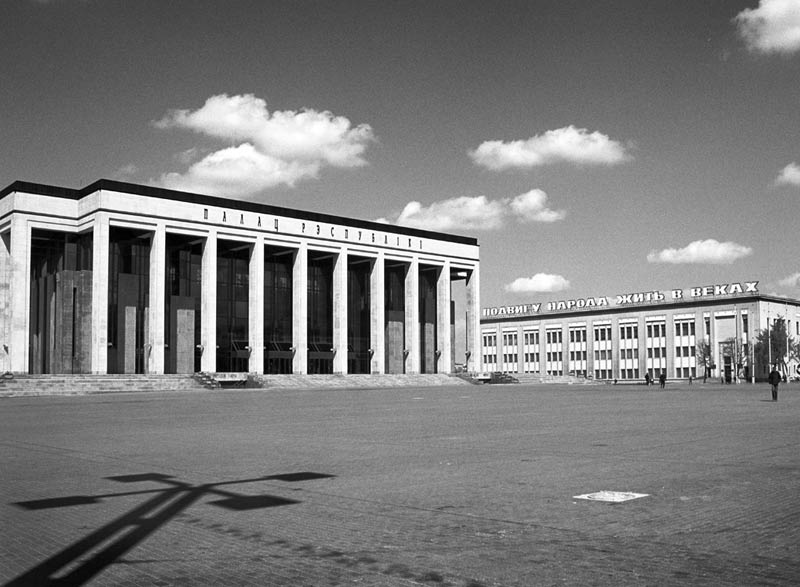
Artur Klinau The Palace of the Republic \ The Sun City of Dream Series
So why haven’t they fancied it so far?
A. K.: Because it is not enough to have the Sun City on our territory. The French, Germans and Swedes should know it is there. Our investment programme consists on three parts: the Sun City proper, Nearby Europeand the Ancestors’ Land. Each of them is aimed at a different target group, but they all promote the brand of Minsk as the Sun City.
The first part is directed at west Europeans, Americans Japanese and so on. We will be able to attract this group in the near future, as the main thing for them is already there. I mean the Sun City. We only have to do three things: (A) prevent it from being ruined by all kinds of glass kitsch, (B) advertise it properly and (C) develop entertainment infrastructure. Point C is the most complicated one, as it does not only involve hotels, restaurants and pubs, but also cultural institutions, such as museums and galleries. We should face up to the fact: Belarus will never have an art museum ranking as high as the Louvre or the Hermitage (at least unless we somehow manage to bring back all our treasures taken away by Russia). We should create new museums, which no one else has and which would go in line with Minsk’s unique character. For example, a Communism Museum.
Do you mean that communism is a specific feature of Belarusian mentality?
A. K.: Of course not.
But the Sun City is a memorial to the Great Communist Utopia. A Communism Museum should have a big display presenting the evolution of the communist idea, beginning from the first utopians, such as Sir Thomas Moore and Tommaso Campanella, its development in France, Germany and other European countries, and the huge social experiment carried out here and elsewhere.
It has to be a new type of museum, with an interactive display, like that at the Holocaust Museum in New York or the Warsaw Uprising Museum. It is a spectacle in its best sense, which engages the visitor. We could also change the War Museum display along the same lines. We live in a country which was the battlefield in the bloody wars of the two civilisations for over 500 years. The front line of World War I also crossed Belarus. It could all be very interesting for foreign tourists. The Communism Museum could be an important element in an advertising campaign to promote a new tourist brand of the Sun City.
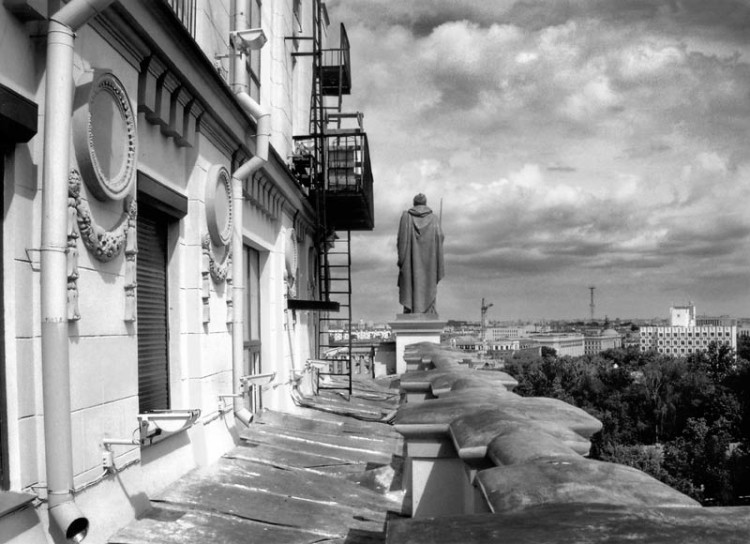
Artur Klinau Guards \ The Sun City of Dream Series
Well, the War Museum, the Communism Museum… Don’t you think such dished are too heavy for foreign gourmets?
A. K.: There are other exotic foods on our menu, ranging from rather simple ones, like a Belarusian Vodka Museum, to quite sophisticated. Everyone knows our world-famous countryman Mark Shagall. Unfortunately, he was not born in Minsk. However, the birthplace of another world-famous artist Haim Sutin is quite close to the capital. It would be a good idea to create a Haim Sutin Museum here. Of course, that would involve purchasing his paintings. But we already have quite enough interesting works to found a Socialist Realism Museum. Whatever we think of this style, it made a whole epoch in art history. As the time passes, people will take more and more interest in it.
The Museum of Modern Art is another burning issue. It is high time to transform it from just an exhibition hall into a real modern art museum, with a unique collection and a building of its own. As for the lack of art galleries, the problem could be easily solved if the government granted them tax cuts and preferential rent rates. Or it would be still better to give some old factory or a whole street to galleries.
Now, what is the second part of your program about? You call it Nearby Europe, don’t you?
A. K.: Nearby Europe is oriented towards Russian tourists. Back in the USSR, having no opportunities to travel abroad, we viewed the Baltic Republics as Europe. We went to Vilnia, Riga or Tallinn for a weekend, just to have a coffee in a cosy bar and walk along old streets. That was our nearby Europe. Today Mensk could become the same kind of Nearby Europe for Russians.
So what should we do to attract them?
A. K.: First and foremost, we should maximally restore the Old Town. At present the old Minsk is divided into separate parts by two main roads, i. e. Niamiha and Pieramohi Avenue. It is vital to divert transit traffic from the historical centre. We must link the separated blocks into a single big old town. In its style it will be similar to Vilnia. In fact, both the towns were designed by the same architects. If we manage to restore the old town, we will only have to develop tourist infrastructure of hotels, good bars serving Belarusian cuisine and easily affordable pubs, as well as active entertainment infrastructure, such as nightclubs, jazz/blues cafes, casinos, aquaparks, etc. We also have to keep in mind the castles in Mir, Niasviź and Navahradak, which can attract visitors from Russia.
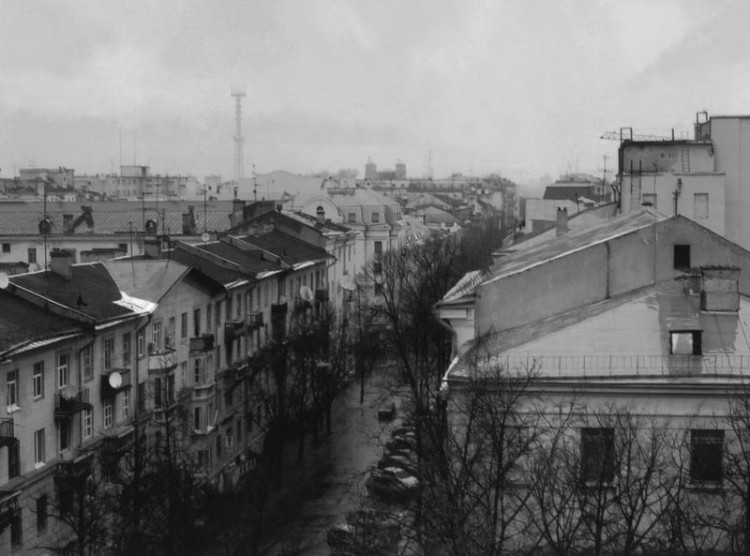
Artur Klinau In the Rain \ The Sun City of Dream Series
And who is the third part of your programme, called the Ancestors’ Land, aimed at?
A. K.: It is about ethnic tourism.
Belarus has always been a multireligious and multiethnic land, home to Poles, Russians, Tatars and Jews.
The Ancestors’ Land is mainly aimed at Poles and Jews. Today Polish visitors already make quite a big proportion of tourists coming to Belarus. A lot of cultural figures of Polish culture come from Minsk. Why do not create museums of Moniuszko and Streminski, who is one of the most prominent Polish artists of the 20th century, born in Minsk? We have a good collection of Sarmatian portraits. So why not create a Museum of Sarmatian Culture? It would be of great interest not only to Poles, but also to visitors from other countries. As for the Jews, an amazing number of the nation’s cult figures come from Belarus: from the founders of Hollywood to the founding fathers of the State of Israel. Our country was probably the only part of Europe were Jews for centuries lived in peace. Our cultures are interconnected. Belarus really became for the Jews the second Promised Land.
To implement this part of the project, it would be a good idea to found a Museum of Jewish culture and restore a Jewish block with a synagogue, shops and kosher restaurants. It would not only be a business but also a revival of tradition, an act of historical justice. Minsk would regain some of its multireligious and multiethnic character. If we manage to carry out at least part of these proposals, Minsk will really become a major European tourist centre.
Let us get back to the figures. You mentioned $500 million tourists would spend in the city annually plus billions of direct investment. What are your estimates based on?
A. K.: On a comparative analysis of tourist trade in Prague and Warsaw, east European capital cities, which are similar to Minsk in many aspects. The number of visitors buying package tours to Warsaw is 3 million annually. We modestly set a target of one million, which is three times less. Every tourist spends about $400–500 on a hotel, food, shopping, gifts, entertainment, etc. This makes half a billion dollars annually.
Could you outline a step-by-step strategy to fulfil your project?
A. K.: First of all, the Sun City must be immediately recognized as a unique architectural complex.
The Sun City and the Old Minsk must acquire a status of historic and architectural preserve. The destruction of the historical centre must be stopped at once, all the issues of its preservation and development must be dealt with within the legal framework.
Secondly, it is a must to reconsider all the projects that potentially pose a threat to the integrity of the preserve. Thirdly, the government must set up a working group to develop a detailed project how to turn Minsk into a major European tourist centre.
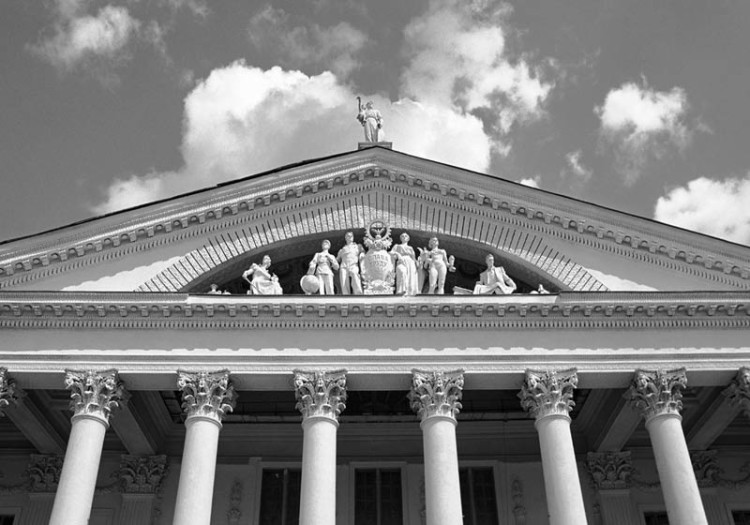
Artur Klinau A Fasade \ The Sun City of Dream Series
If we speak about a historic and cultural preserve, it is necessary to outline its confines. We know what makes the Old Town. But where is the borderline of the Sun City? Is it what we call Stalin’s Empire style, the architecture of socialist realism?
A. K.: Social romanticism, rather. It was Khrushchov who introduced realism in architecture. You know, I am not in favour of the term Stalin’s Empire style, as it has a lot of negative connotations. Besides, it dominated in all of the USSR, but it was only in Minsk that it manifested itself as an integral ‘ideal city’. So the Sun City is a unique phenomenon in its own right within this style, and this is what it should be called: the Sun City. It stretches from Niezaleźnasci Square in the west to Ćaluskincy Park in the east. Its most precious part, which must become a preserve, runs from Niezaleźnasci Square to Jakub Kołas Square.
Still, what’s the problem if a couple of high-rise hotels are erectedon the territory of the Sun City?
A. K.: It is a crucial thing. At present we are the only ones licensed to call ourselves the Sun City. Every piece of architecture ruining its integrity as a whole ensemble kills the mere idea of the Sun City. If we fragment it, we will lose the right to be recognised as the Sun City. I am not saying that nothing should be built on this territory. But all new projects must be in harmony with its aesthetics and style.
And what do you think of the plans to construct big architectural complexes outside the Sun City?
A. K.: I find a lot of them very interesting. Moreover, Minsk-city and the complex around the National library in a way continue the traditions of the Sun City. This is what Minsk as Sun City’2 should be like: futuristic, cosmic, ambitious, open to the sun.
In your opinion, what will the government and the dwellers of the Sun City think of your project?
A. K.: Any government that embarks on such a project, will build themselves a real monument. We are creating Sun City’2 for ourselves in the first place. It is not only a tourist brand, but also a project to turn Minsk into a major European cultural centre. We are in a unique position to say proudly, ‘I was born in the Sun City, I live in the Sun City!’ Belarus has always been a European country. The nation’s history has taken such a turn that we are now excluded from contemporary Europe. But this is not to say that we have stopped being Europeans. We can say to ourselves, ‘We are Europe, we have always been and will be Europe.’ We can restore not only the Europe hotel, but the whole European Miensk and reconcile it with the Sun City as two symbols of one city.
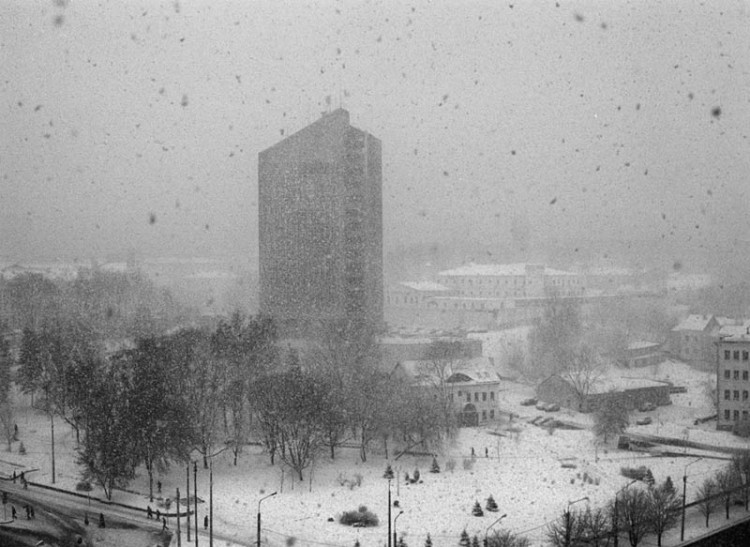
Artur Klinau Archive \ The Sun City of Dream Series
Minsk has had a tragic history. However, today we are given a unique chance to make it into a city which will be equal to Paris, Berlin and Rome. If we miss the chance, we will forever remain dull and provincial, something no one takes any interest in. Time is flowing fast. It may be too late tomorrow.
Artur Klinau, 2009
Opinions of authors do not always reflect the views of pARTisan. If you note any errors, please contact us right away.
.



